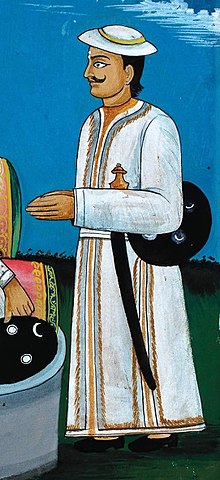Shivaram Singh Basnyat
This article has multiple issues. Please help improve it or discuss these issues on the talk page. (Learn how and when to remove these template messages)
|
Senapati Badabir Shivaram Singh Basnyat | |
|---|---|
| सेनापति बडावीर शिवराम सिंह बस्न्यात | |
 Senapati Shivaram Singh Basnyat consulting King Prithvi Narayan Shah | |
| Chief of Nepalese Army | |
| In office 1743 – February 1747 | |
| Preceded by | Prithivi Narayan Shah |
| Succeeded by | Kalu Pande |
| Personal details | |
| Born | Gorkha Kingdom |
| Died | Sangachok 1747 AD (12th Fagun 1803 B.S.[citation needed]) |
| Children | Naahar Singh Basnyat Kehar Singh Basnyat Abhiman Singh Basnyat Dhokal Singh Basnyat |
| Relatives | see Basnyat dynasty, Pande dynasty, Thapa dynasty |
| Military service | |
| Allegiance | Gorkha Kingdom |
| Rank | General |
| Battles/wars | Unification of Nepal |
Shivaram Singh Basnyat (Nepali: शिवराम सिंह बस्न्यात) was the military commander of Gorkha. After the conquest of Naldum area by the Gorkhalis, he along with Commander Bir Bhadra Thapa conquered Sanga, Panauti, Sankhu and adjacent areas.[1] They received fierce resistance from the Kantipur Kingdom at Sangachok.[2] He died in the defensive battle of Sanga Chowk during Unification of Nepal on 1803 B.S.[3][4]
Personal life[edit]
He was born to Jayaram Singh Basnyat in the clan of Shreepali among Basnyats.[5] He had four sons - Naahar Singh Basnyat, Kehar Singh Basnyat, Abhiman Singh Basnet and Dhokal Singh Basnyat. His third son went on to become Supreme Commander of the Nepalese Army and Chief Minister (Mulkazi) in the Royal Court.[6]
Gallery[edit]
-
Shivaram Singh Basnyat
References[edit]
- ^ Khatri 1999, p. 18.
- ^ Regmi 1975, p. 108.
- ^ Shaha 1990, p. 27.
- ^ Hamal 1995, p. 104.
- ^ Hamal 1995, p. 182.
- ^ Khatri 1999, p. 39.
Sources[edit]
- Khatri, Shiva Ram (1999), Nepal Army Chiefs:Short Biographical Sketches, University of Michigan: Sira Khatri
- Regmi, D.R. (1975), Modern Nepal, vol. 1, Firma K.L. Mukhopadhyay, ISBN 0883864916
- Shaha, Rishikesh (1990), Modern Nepal 1769–1885, Riverdale Company, ISBN 0-913215-64-3
- Hamal, Lakshman B. (1995), Military history of Nepal, Sharda Pustak Mandir, p. 125, OCLC 32779233

